<- previous index next ->
Why did I choose to use triangles in Lecture 21,
3 point surface, rather than 4 point surface?
Answer: For efficiency and ease of coding for lighting.
There are many types of renderer's as covered in Lecture 18.
For this lecture I am focusing on a renderer that will use
Phong Specular Lighting and thus requires normals to surfaces
that are interpolated across the surface.
To understand relative efficiency, in this case twice as many
3 point surfaces as four point surfaces for the same object,
both the data structures and the processing must be analyzed.
The data structures, copied from working code, are:
typedef struct {GLfloat x; GLfloat y; GLfloat z;
GLfloat nx; GLfloat ny; GLfloat nz;} dpts;
static dpts * data_points; /* malloc'd space for vertices */
Note: x,y,z is a point, vertex, on a surface, nx,ny,nz is a vector
from that point in the direction of the outward normal to the surface.
For example, OpenGL code using normals and vertices:
glNormal3f(data_points[k-1].nx, data_points[k-1].ny, data_points[k-1].nz);
glVertex3f(data_points[k-1].x, data_points[k-1].y, data_points[k-1].z);
With precomputed normals from:
for(i=0; i<num_pts; i++)
{
/* get &data_points[i].x, &data_points[i].y, &data_points[i].z */
data_points[i].nx = 0.0; /* normals averaged and normalized */
data_points[i].ny = 0.0;
data_points[i].nz = 0.0;
}
/* pick up three points, pts, of a polygon */
/* v[0], v[1], v[2] three point triangle */
for(j=0; j<3; j++)
v[j] = data_points[kk[j]-1];
/* compute, normalize and average normals */
ax = v[2].x - v[1].x;
ay = v[2].y - v[1].y;
az = v[2].z - v[1].z;
bx = v[1].x - v[0].x;
by = v[1].y - v[0].y;
bz = v[1].z - v[0].z;
nx = ay*bz-az*by; /* cross product */
ny = az*bx-ax*bz;
nz = ax*by-ay*bx; /* technically, the normal at point [1] */
s = sqrt(nx*nx + ny*ny + nz*nz);
nx = nx / s; /* normalize to length = 1.0 */
ny = ny / s;
nz = nz / s;
for(j=0; j<j; j++)
{
data_points[kk[j]-1].nx += nx; /* sum normals */
data_points[kk[j]-1].ny += ny;
data_points[kk[j]-1].nz += nz;
}
for(j=3; j<pts; j++)
{
/* if more than 3 points, compute normal at every vertex */
/* repeat 13 lines above for points other than [1] */
}
I have provided the utility files to read, write and clean the
".dat" and binary form ".det" files that can be used with OpenGL
and other applications.
The basic capabilities are shown in datread.h
The code is in datread.c
Three sample uses that provide various OpenGL viewers for .dat files are
light_dat.c
light_dat2.c
light_dat3.c
light_dat.java
Some screen shots are

 Now, suppose you want to edit a 3D image.
Possibly by picking a point and pulling it.
What can we give the used to help pick the points?
a) wireframe display with color change
b) vertex display with color change
c) trimmed vertex display with color change
d) color depths with various shades
Demonstrate light_dat3 skull.dat
w h to rotate, mouse to pick a vertex
note color change to show "pick"
v now vertices, mouse to pick
t trims vertices that should be hidden
less clutter
c (work in progress) show depth as various shades
Notice that a closed volume has an inside and an outside.
Most graphics software requires the normal vector to point outward.
An open volume may have a different color on the inside from the
color on the outside. Generally surfaces are given by triangles,
rectangles or polygons. The convention is to list the vertices
in counter clockwise order ( CCW ). The figure below is a cube
with the six surfaces flattened and the eight vertices labeled.
The order of the vertices allows the computation of the normal
to be an outgoing vector.
Now, suppose you want to edit a 3D image.
Possibly by picking a point and pulling it.
What can we give the used to help pick the points?
a) wireframe display with color change
b) vertex display with color change
c) trimmed vertex display with color change
d) color depths with various shades
Demonstrate light_dat3 skull.dat
w h to rotate, mouse to pick a vertex
note color change to show "pick"
v now vertices, mouse to pick
t trims vertices that should be hidden
less clutter
c (work in progress) show depth as various shades
Notice that a closed volume has an inside and an outside.
Most graphics software requires the normal vector to point outward.
An open volume may have a different color on the inside from the
color on the outside. Generally surfaces are given by triangles,
rectangles or polygons. The convention is to list the vertices
in counter clockwise order ( CCW ). The figure below is a cube
with the six surfaces flattened and the eight vertices labeled.
The order of the vertices allows the computation of the normal
to be an outgoing vector.
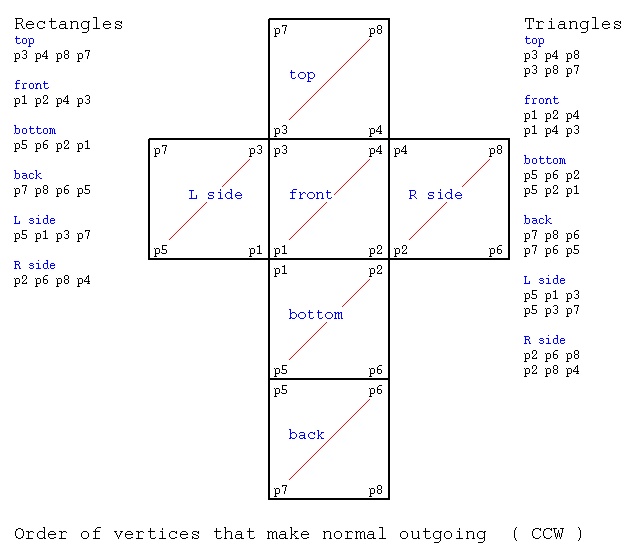 One specific format, the .dat (ASCII) or .det (binary) is:
number-of-vertices number-of-polygons
x1 y1 z1 three floating point numbers
x2 y2 z2
...
xn yn zn n = number of vertices
c1 vi vj vk ... vc1 vertex numbers starting with 1, c1 of them
c2 vl vn vm each line can have different number of points
...
cm va vb vc m = number-of-polygons
Example file acube.dat (annotation, not part of file)
8 6
0.0 0.0 0.0 p1
1.0 0.0 0.0 p2
0.0 1.0 0.0 p3
1.0 1.0 0.0 p4
0.0 0.0 1.0 p5
1.0 0.0 1.0 p6
0.0 1.0 1.0 p7
1.0 1.0 1.0 p8
4 3 4 8 7 top
4 1 2 4 3 front
4 5 6 2 1 bottom
4 7 8 6 5 back
4 5 1 3 7 L side
4 2 6 8 4 R side
A .stl ASCII file consists of triangles and the normals
with lots of labeling as in cube2.stl
We can convert binary .stl files to readable ASCII files using
stl_btoa.c
Examples are converting pot.stl to apot.stl and planter.stl to aplanter.stl.
binary pot.stl
readable apot.stl
binary planter.stl
readable aplanter.stl
Then we can translate binary .stl to Utah Graphics .dat and plot.
stl_to_dat.c
Examples are converting pot.stl to pot.dat and planter.stl to planter.dat.
readable pot.dat
readable planter.dat
One specific format, the .dat (ASCII) or .det (binary) is:
number-of-vertices number-of-polygons
x1 y1 z1 three floating point numbers
x2 y2 z2
...
xn yn zn n = number of vertices
c1 vi vj vk ... vc1 vertex numbers starting with 1, c1 of them
c2 vl vn vm each line can have different number of points
...
cm va vb vc m = number-of-polygons
Example file acube.dat (annotation, not part of file)
8 6
0.0 0.0 0.0 p1
1.0 0.0 0.0 p2
0.0 1.0 0.0 p3
1.0 1.0 0.0 p4
0.0 0.0 1.0 p5
1.0 0.0 1.0 p6
0.0 1.0 1.0 p7
1.0 1.0 1.0 p8
4 3 4 8 7 top
4 1 2 4 3 front
4 5 6 2 1 bottom
4 7 8 6 5 back
4 5 1 3 7 L side
4 2 6 8 4 R side
A .stl ASCII file consists of triangles and the normals
with lots of labeling as in cube2.stl
We can convert binary .stl files to readable ASCII files using
stl_btoa.c
Examples are converting pot.stl to apot.stl and planter.stl to aplanter.stl.
binary pot.stl
readable apot.stl
binary planter.stl
readable aplanter.stl
Then we can translate binary .stl to Utah Graphics .dat and plot.
stl_to_dat.c
Examples are converting pot.stl to pot.dat and planter.stl to planter.dat.
readable pot.dat
readable planter.dat
 pot.png plotted with light_dat.java, trim with gimp
pot.png plotted with light_dat.java, trim with gimp
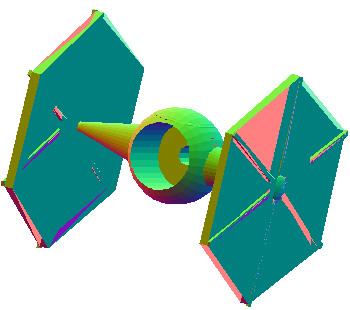 planter.png plotted with light_dat.java, trim with gimp
Note that most 3D printers are using .stl files to generate
3D objects.
3D printer uses
We can convert .dat files to .stl files
dat_to_stl.java
We can convert .stl files to .dat files
stl_to_dat.java
We can directly display 3D .stl files
light_stl.java
light_stl.py3
light_normal_stl.java
stl_scale.java change size
planter.png plotted with light_dat.java, trim with gimp
Note that most 3D printers are using .stl files to generate
3D objects.
3D printer uses
We can convert .dat files to .stl files
dat_to_stl.java
We can convert .stl files to .dat files
stl_to_dat.java
We can directly display 3D .stl files
light_stl.java
light_stl.py3
light_normal_stl.java
stl_scale.java change size
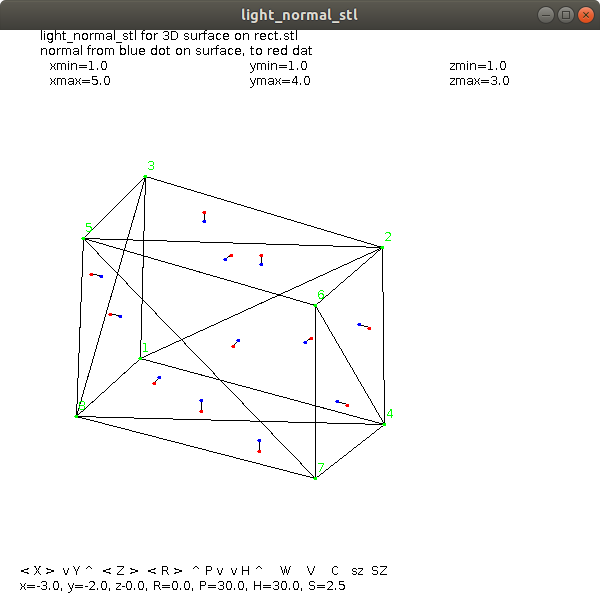 cube.stl
cube.stl
 coming soon 3D printer
Neither of the above files contain color information.
They just define the shape of an object.
A renderer takes a control file that places many objects and
applies color and shading to the objects. One such file is
lab6_input1 shown below:
device: lab6_input1.rle
postscript: lab6_input1.ps
debug: 1
viewport: 400 400
coi: 0 0 0
hither_yon: 1 100
observer: 4 1 20
angle: 8.0
light_position: 10 30 30
light_color: 1 1 1
object: drop.dat
color_type: 1 1 0 0
illumination_parameters: .2 .8 1.0 50
shading: phong
rotate: 45 30 60
scale: 1 1 1
translate: .25 -.36 0
object: drop.dat
color_type: 1 1 1 0
illumination_parameters: .25 .75 1.0 10
shading: phong
rotate: 0 0 180
scale: 1 1 1
translate: 0 .6 0
object: cube.dat
illumination_parameters: .3 .70 0.0 10
shading: phong
color_type: 1 1 .5 .5
scale: 2 2 .1
translate: 0 0 -.5
object: cube.dat
shading: phong
color_type: 1 .2 .9 1
illumination_parameters: .25 .75 1.0 100
scale: 2.0 .2 2.0
translate: 0 -1.0 .5
end
Note: shading, color, illumination, scale and position (translate)
are given for each object. Global parameters include window size,
center of interest, truncated prism specification, files, etc.
The result of the above scene is shown below.
coming soon 3D printer
Neither of the above files contain color information.
They just define the shape of an object.
A renderer takes a control file that places many objects and
applies color and shading to the objects. One such file is
lab6_input1 shown below:
device: lab6_input1.rle
postscript: lab6_input1.ps
debug: 1
viewport: 400 400
coi: 0 0 0
hither_yon: 1 100
observer: 4 1 20
angle: 8.0
light_position: 10 30 30
light_color: 1 1 1
object: drop.dat
color_type: 1 1 0 0
illumination_parameters: .2 .8 1.0 50
shading: phong
rotate: 45 30 60
scale: 1 1 1
translate: .25 -.36 0
object: drop.dat
color_type: 1 1 1 0
illumination_parameters: .25 .75 1.0 10
shading: phong
rotate: 0 0 180
scale: 1 1 1
translate: 0 .6 0
object: cube.dat
illumination_parameters: .3 .70 0.0 10
shading: phong
color_type: 1 1 .5 .5
scale: 2 2 .1
translate: 0 0 -.5
object: cube.dat
shading: phong
color_type: 1 .2 .9 1
illumination_parameters: .25 .75 1.0 100
scale: 2.0 .2 2.0
translate: 0 -1.0 .5
end
Note: shading, color, illumination, scale and position (translate)
are given for each object. Global parameters include window size,
center of interest, truncated prism specification, files, etc.
The result of the above scene is shown below.
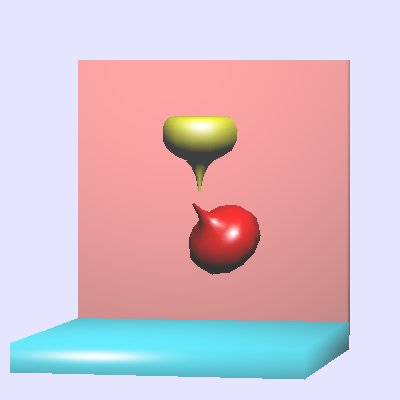 Many other file formats are avaiable, and ugh! used.
e.g. .nff is used by many raytrace programs
NFF file format
jon_1.nff
Many other file formats are avaiable, and ugh! used.
e.g. .nff is used by many raytrace programs
NFF file format
jon_1.nff
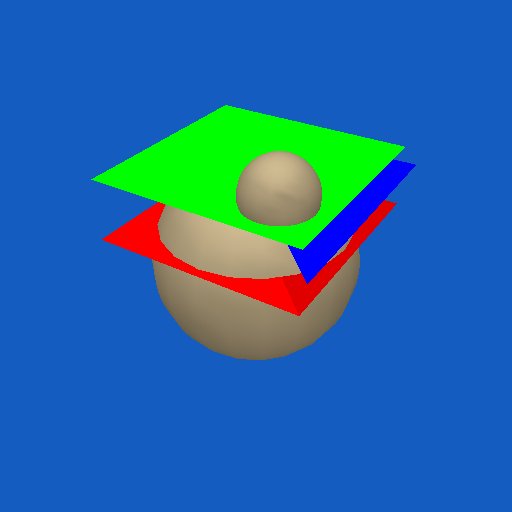 UMBC Game Track makes national news:
From: technews
Subject: ACM TechNews; Wednesday, April 23, 2008
Read the TechNews Online at: http://technews.acm.org
HEADLINES AT A GLANCE:
* Serious About Games
Serious About Games
Baltimore Sun (04/20/08) P. 1A; Emery, Chris
Nearly 400 U.S. colleges and universities, including MIT and Carnegie
Mellon, now offer formal training in game development, ranging from
elective courses to full degree programs. The increasing complexity
of computers and game systems requires teams of dozens of artists,
producers, and programmers to create a game. "Twenty years ago, a
game was made by one guy, or two or three people," says International
Game Developers Association executive director Jason Della Rocca.
"The games you see now take up to 200 people to make. You need a more
institutionalized pipeline of training developers." Vocational
schools have a lead in issuing certificates in game development, but
universities are catching up as more students demand full degree
programs.
The University of Maryland Baltimore County's program
provides broad-based training in visual arts and computer science.
UMBC computer science professor Marc Olano says the school's gaming
classes are designed to give students a solid education that will
make them employable outside of the game industry. However, there are
plenty of jobs for gaming majors. The average developer's salary was
$73,000 last year, according to Game Developer magazine, while
computer and video game sales have tripled since 1996. "Students are
demanding these types of programs, and schools are listening," Della
Rocca says. "These classes do well in terms of filling classrooms."
Click Here to View Full Article - Web Link May Require Free Registration
UMBC Game Track makes national news:
From: technews
Subject: ACM TechNews; Wednesday, April 23, 2008
Read the TechNews Online at: http://technews.acm.org
HEADLINES AT A GLANCE:
* Serious About Games
Serious About Games
Baltimore Sun (04/20/08) P. 1A; Emery, Chris
Nearly 400 U.S. colleges and universities, including MIT and Carnegie
Mellon, now offer formal training in game development, ranging from
elective courses to full degree programs. The increasing complexity
of computers and game systems requires teams of dozens of artists,
producers, and programmers to create a game. "Twenty years ago, a
game was made by one guy, or two or three people," says International
Game Developers Association executive director Jason Della Rocca.
"The games you see now take up to 200 people to make. You need a more
institutionalized pipeline of training developers." Vocational
schools have a lead in issuing certificates in game development, but
universities are catching up as more students demand full degree
programs.
The University of Maryland Baltimore County's program
provides broad-based training in visual arts and computer science.
UMBC computer science professor Marc Olano says the school's gaming
classes are designed to give students a solid education that will
make them employable outside of the game industry. However, there are
plenty of jobs for gaming majors. The average developer's salary was
$73,000 last year, according to Game Developer magazine, while
computer and video game sales have tripled since 1996. "Students are
demanding these types of programs, and schools are listening," Della
Rocca says. "These classes do well in terms of filling classrooms."
Click Here to View Full Article - Web Link May Require Free Registration
<- previous index next ->
Many web sites on Java GUI, AWT, Swing, etc.
Many web sites on Python wx, tk, qt, etc.

 Now, suppose you want to edit a 3D image.
Possibly by picking a point and pulling it.
What can we give the used to help pick the points?
a) wireframe display with color change
b) vertex display with color change
c) trimmed vertex display with color change
d) color depths with various shades
Demonstrate light_dat3 skull.dat
w h to rotate, mouse to pick a vertex
note color change to show "pick"
v now vertices, mouse to pick
t trims vertices that should be hidden
less clutter
c (work in progress) show depth as various shades
Notice that a closed volume has an inside and an outside.
Most graphics software requires the normal vector to point outward.
An open volume may have a different color on the inside from the
color on the outside. Generally surfaces are given by triangles,
rectangles or polygons. The convention is to list the vertices
in counter clockwise order ( CCW ). The figure below is a cube
with the six surfaces flattened and the eight vertices labeled.
The order of the vertices allows the computation of the normal
to be an outgoing vector.
Now, suppose you want to edit a 3D image.
Possibly by picking a point and pulling it.
What can we give the used to help pick the points?
a) wireframe display with color change
b) vertex display with color change
c) trimmed vertex display with color change
d) color depths with various shades
Demonstrate light_dat3 skull.dat
w h to rotate, mouse to pick a vertex
note color change to show "pick"
v now vertices, mouse to pick
t trims vertices that should be hidden
less clutter
c (work in progress) show depth as various shades
Notice that a closed volume has an inside and an outside.
Most graphics software requires the normal vector to point outward.
An open volume may have a different color on the inside from the
color on the outside. Generally surfaces are given by triangles,
rectangles or polygons. The convention is to list the vertices
in counter clockwise order ( CCW ). The figure below is a cube
with the six surfaces flattened and the eight vertices labeled.
The order of the vertices allows the computation of the normal
to be an outgoing vector.
 One specific format, the .dat (ASCII) or .det (binary) is:
number-of-vertices number-of-polygons
x1 y1 z1 three floating point numbers
x2 y2 z2
...
xn yn zn n = number of vertices
c1 vi vj vk ... vc1 vertex numbers starting with 1, c1 of them
c2 vl vn vm each line can have different number of points
...
cm va vb vc m = number-of-polygons
Example file acube.dat (annotation, not part of file)
8 6
0.0 0.0 0.0 p1
1.0 0.0 0.0 p2
0.0 1.0 0.0 p3
1.0 1.0 0.0 p4
0.0 0.0 1.0 p5
1.0 0.0 1.0 p6
0.0 1.0 1.0 p7
1.0 1.0 1.0 p8
4 3 4 8 7 top
4 1 2 4 3 front
4 5 6 2 1 bottom
4 7 8 6 5 back
4 5 1 3 7 L side
4 2 6 8 4 R side
A .stl ASCII file consists of triangles and the normals
with lots of labeling as in cube2.stl
We can convert binary .stl files to readable ASCII files using
stl_btoa.c
Examples are converting pot.stl to apot.stl and planter.stl to aplanter.stl.
binary pot.stl
readable apot.stl
binary planter.stl
readable aplanter.stl
Then we can translate binary .stl to Utah Graphics .dat and plot.
stl_to_dat.c
Examples are converting pot.stl to pot.dat and planter.stl to planter.dat.
readable pot.dat
readable planter.dat
One specific format, the .dat (ASCII) or .det (binary) is:
number-of-vertices number-of-polygons
x1 y1 z1 three floating point numbers
x2 y2 z2
...
xn yn zn n = number of vertices
c1 vi vj vk ... vc1 vertex numbers starting with 1, c1 of them
c2 vl vn vm each line can have different number of points
...
cm va vb vc m = number-of-polygons
Example file acube.dat (annotation, not part of file)
8 6
0.0 0.0 0.0 p1
1.0 0.0 0.0 p2
0.0 1.0 0.0 p3
1.0 1.0 0.0 p4
0.0 0.0 1.0 p5
1.0 0.0 1.0 p6
0.0 1.0 1.0 p7
1.0 1.0 1.0 p8
4 3 4 8 7 top
4 1 2 4 3 front
4 5 6 2 1 bottom
4 7 8 6 5 back
4 5 1 3 7 L side
4 2 6 8 4 R side
A .stl ASCII file consists of triangles and the normals
with lots of labeling as in cube2.stl
We can convert binary .stl files to readable ASCII files using
stl_btoa.c
Examples are converting pot.stl to apot.stl and planter.stl to aplanter.stl.
binary pot.stl
readable apot.stl
binary planter.stl
readable aplanter.stl
Then we can translate binary .stl to Utah Graphics .dat and plot.
stl_to_dat.c
Examples are converting pot.stl to pot.dat and planter.stl to planter.dat.
readable pot.dat
readable planter.dat
 pot.png plotted with light_dat.java, trim with gimp
pot.png plotted with light_dat.java, trim with gimp
 planter.png plotted with light_dat.java, trim with gimp
Note that most 3D printers are using .stl files to generate
3D objects.
3D printer uses
We can convert .dat files to .stl files
dat_to_stl.java
We can convert .stl files to .dat files
stl_to_dat.java
We can directly display 3D .stl files
light_stl.java
light_stl.py3
light_normal_stl.java
stl_scale.java change size
planter.png plotted with light_dat.java, trim with gimp
Note that most 3D printers are using .stl files to generate
3D objects.
3D printer uses
We can convert .dat files to .stl files
dat_to_stl.java
We can convert .stl files to .dat files
stl_to_dat.java
We can directly display 3D .stl files
light_stl.java
light_stl.py3
light_normal_stl.java
stl_scale.java change size
 cube.stl
cube.stl
 coming soon 3D printer
Neither of the above files contain color information.
They just define the shape of an object.
A renderer takes a control file that places many objects and
applies color and shading to the objects. One such file is
lab6_input1 shown below:
device: lab6_input1.rle
postscript: lab6_input1.ps
debug: 1
viewport: 400 400
coi: 0 0 0
hither_yon: 1 100
observer: 4 1 20
angle: 8.0
light_position: 10 30 30
light_color: 1 1 1
object: drop.dat
color_type: 1 1 0 0
illumination_parameters: .2 .8 1.0 50
shading: phong
rotate: 45 30 60
scale: 1 1 1
translate: .25 -.36 0
object: drop.dat
color_type: 1 1 1 0
illumination_parameters: .25 .75 1.0 10
shading: phong
rotate: 0 0 180
scale: 1 1 1
translate: 0 .6 0
object: cube.dat
illumination_parameters: .3 .70 0.0 10
shading: phong
color_type: 1 1 .5 .5
scale: 2 2 .1
translate: 0 0 -.5
object: cube.dat
shading: phong
color_type: 1 .2 .9 1
illumination_parameters: .25 .75 1.0 100
scale: 2.0 .2 2.0
translate: 0 -1.0 .5
end
Note: shading, color, illumination, scale and position (translate)
are given for each object. Global parameters include window size,
center of interest, truncated prism specification, files, etc.
The result of the above scene is shown below.
coming soon 3D printer
Neither of the above files contain color information.
They just define the shape of an object.
A renderer takes a control file that places many objects and
applies color and shading to the objects. One such file is
lab6_input1 shown below:
device: lab6_input1.rle
postscript: lab6_input1.ps
debug: 1
viewport: 400 400
coi: 0 0 0
hither_yon: 1 100
observer: 4 1 20
angle: 8.0
light_position: 10 30 30
light_color: 1 1 1
object: drop.dat
color_type: 1 1 0 0
illumination_parameters: .2 .8 1.0 50
shading: phong
rotate: 45 30 60
scale: 1 1 1
translate: .25 -.36 0
object: drop.dat
color_type: 1 1 1 0
illumination_parameters: .25 .75 1.0 10
shading: phong
rotate: 0 0 180
scale: 1 1 1
translate: 0 .6 0
object: cube.dat
illumination_parameters: .3 .70 0.0 10
shading: phong
color_type: 1 1 .5 .5
scale: 2 2 .1
translate: 0 0 -.5
object: cube.dat
shading: phong
color_type: 1 .2 .9 1
illumination_parameters: .25 .75 1.0 100
scale: 2.0 .2 2.0
translate: 0 -1.0 .5
end
Note: shading, color, illumination, scale and position (translate)
are given for each object. Global parameters include window size,
center of interest, truncated prism specification, files, etc.
The result of the above scene is shown below.
 Many other file formats are avaiable, and ugh! used.
e.g. .nff is used by many raytrace programs
NFF file format
jon_1.nff
Many other file formats are avaiable, and ugh! used.
e.g. .nff is used by many raytrace programs
NFF file format
jon_1.nff
 UMBC Game Track makes national news:
From: technews
UMBC Game Track makes national news:
From: technews